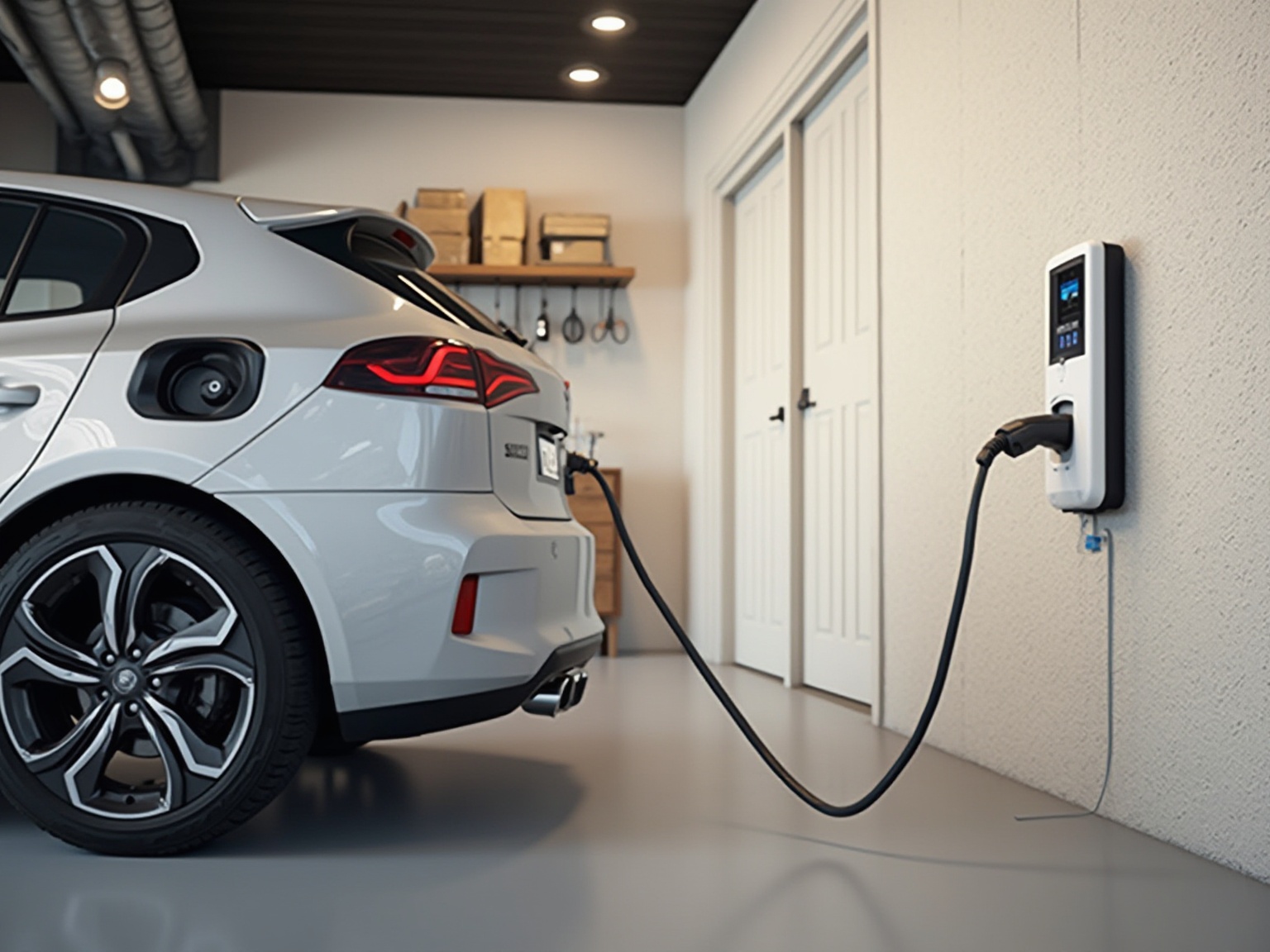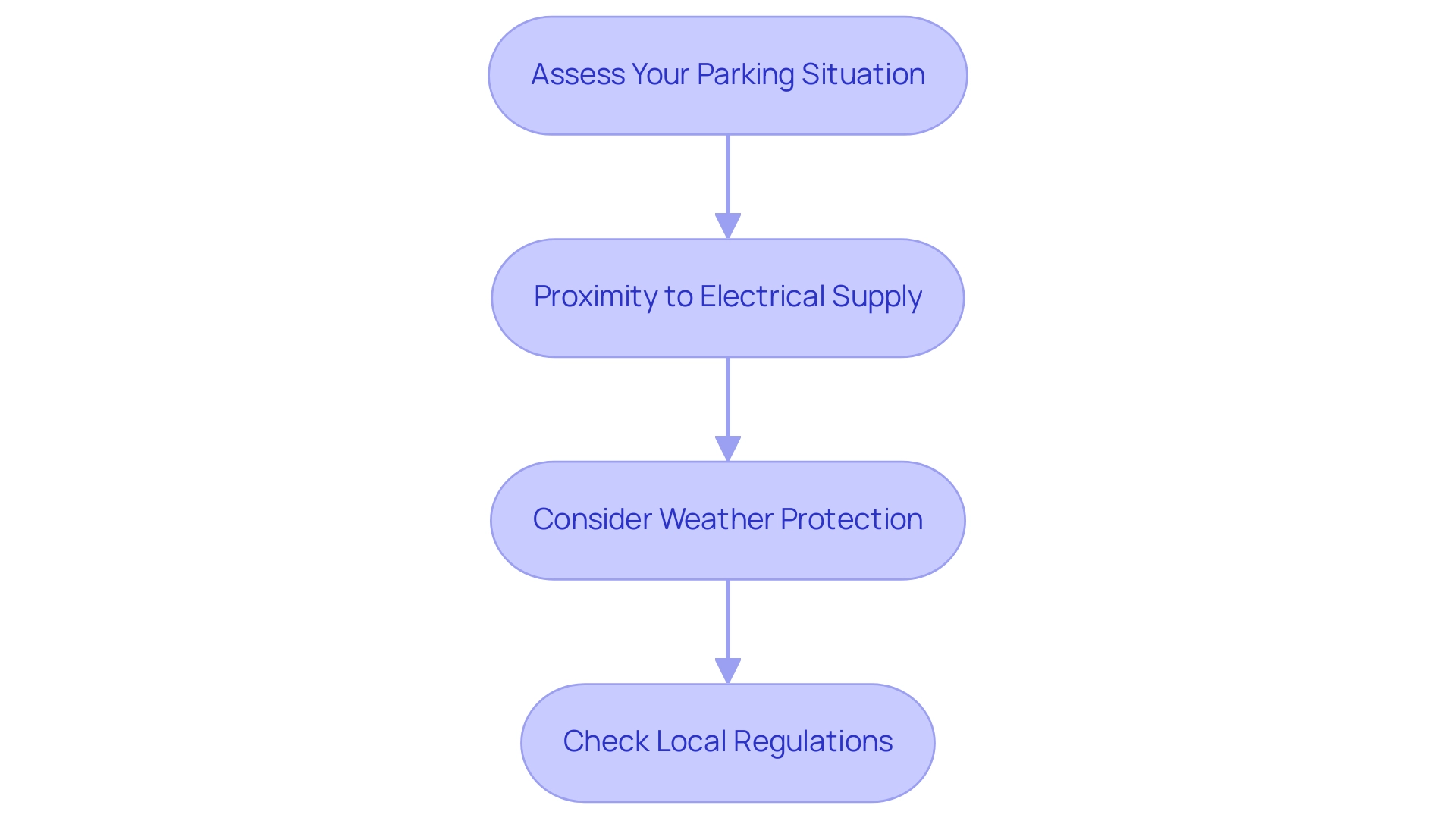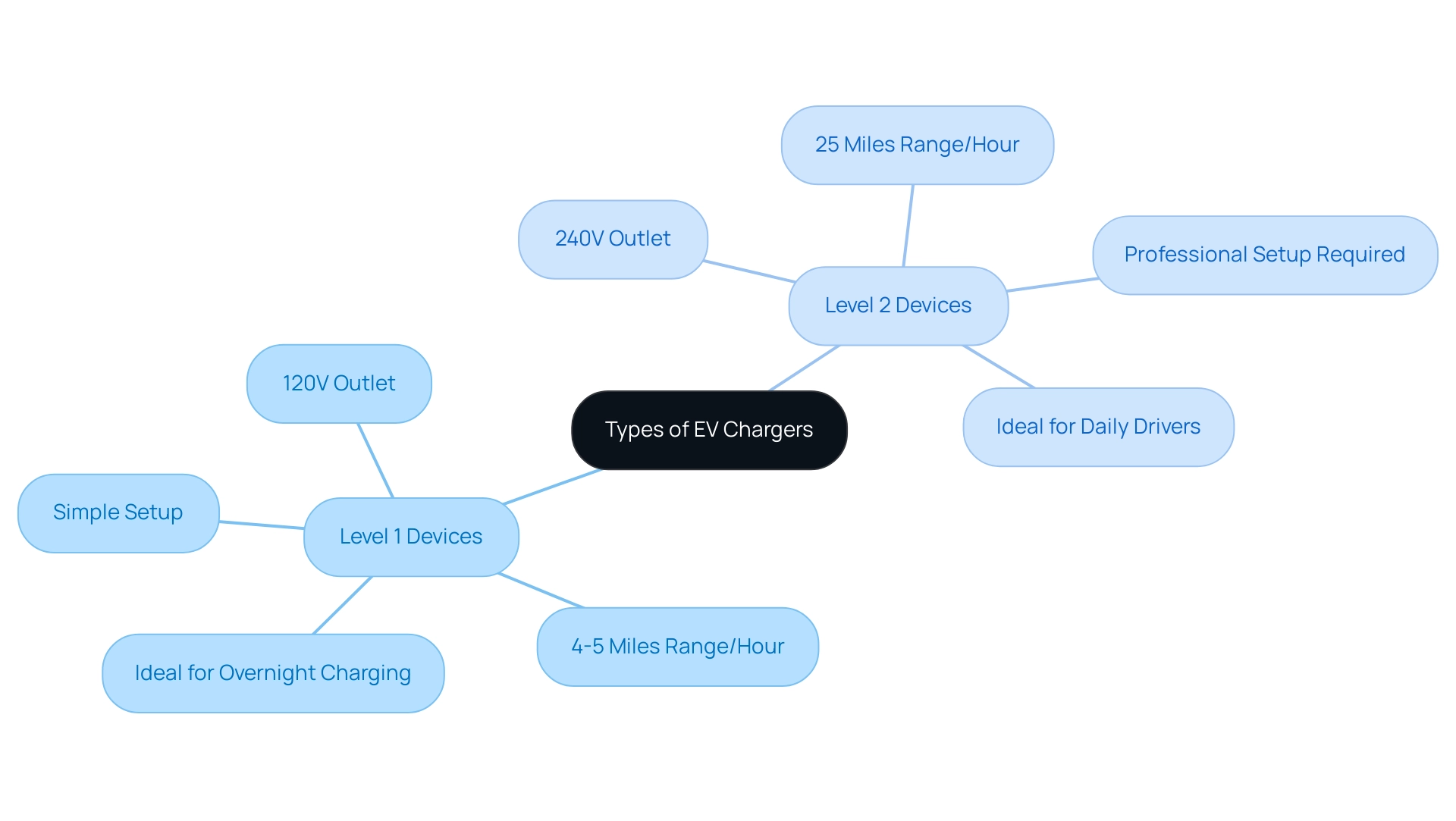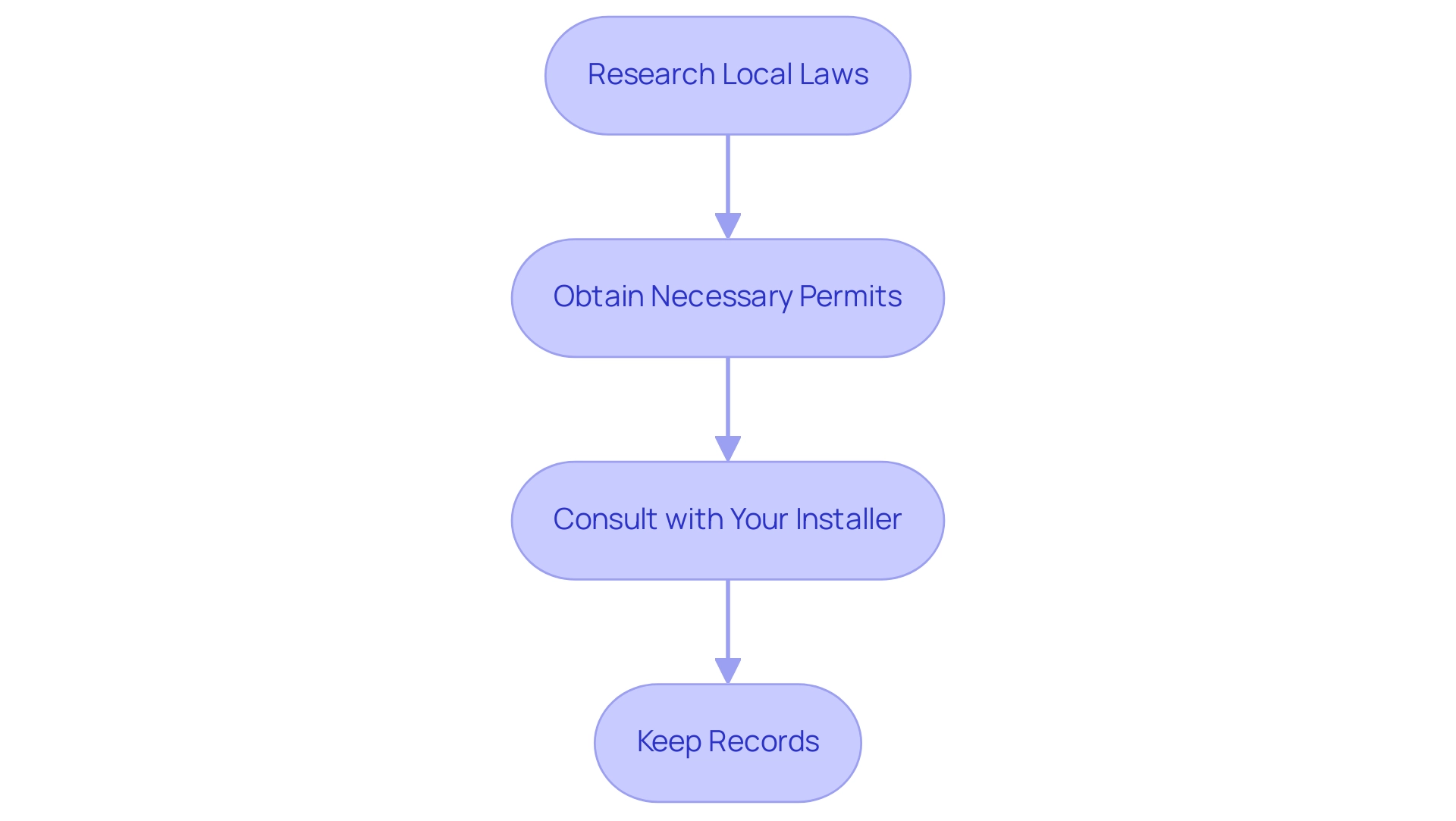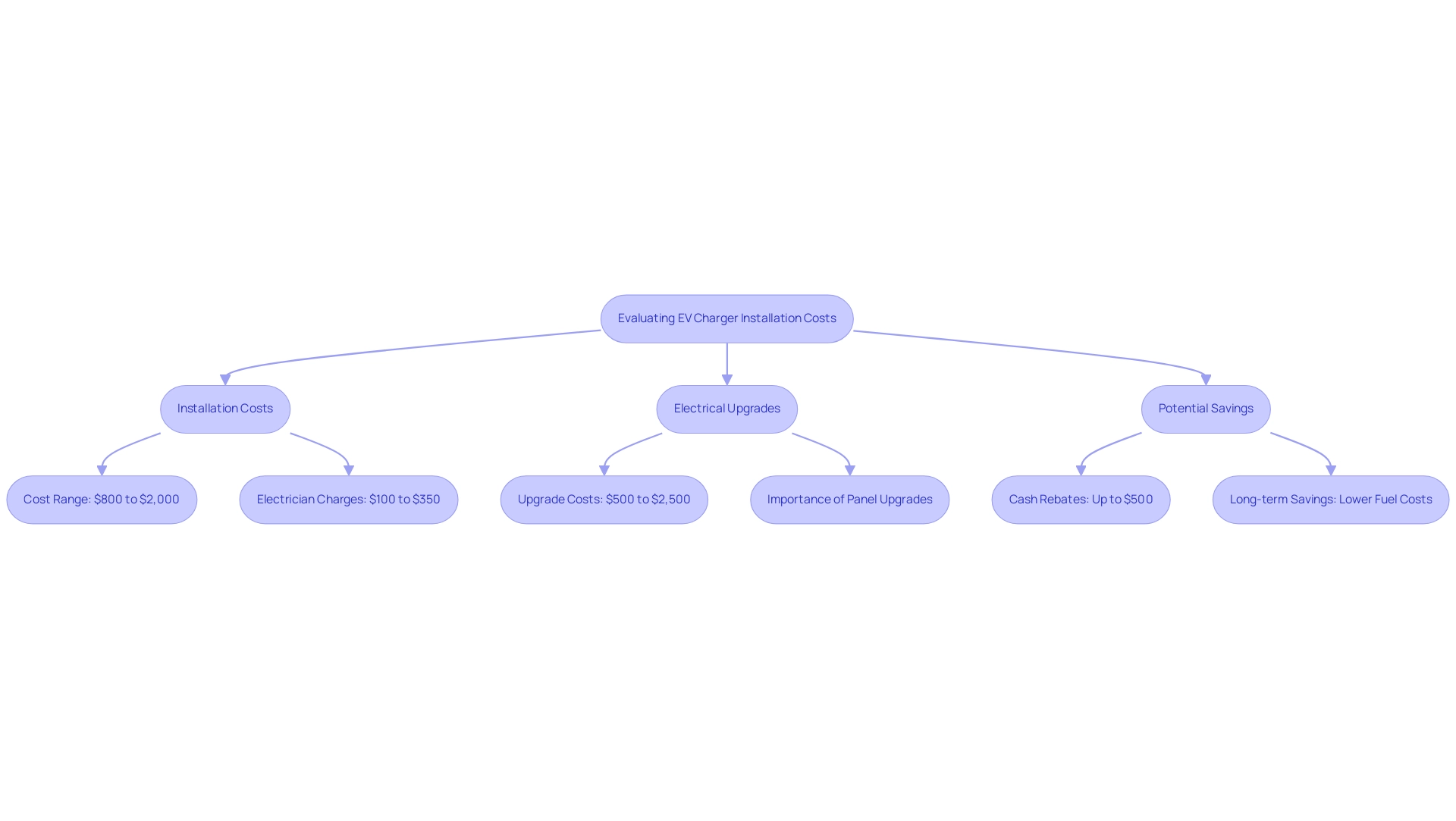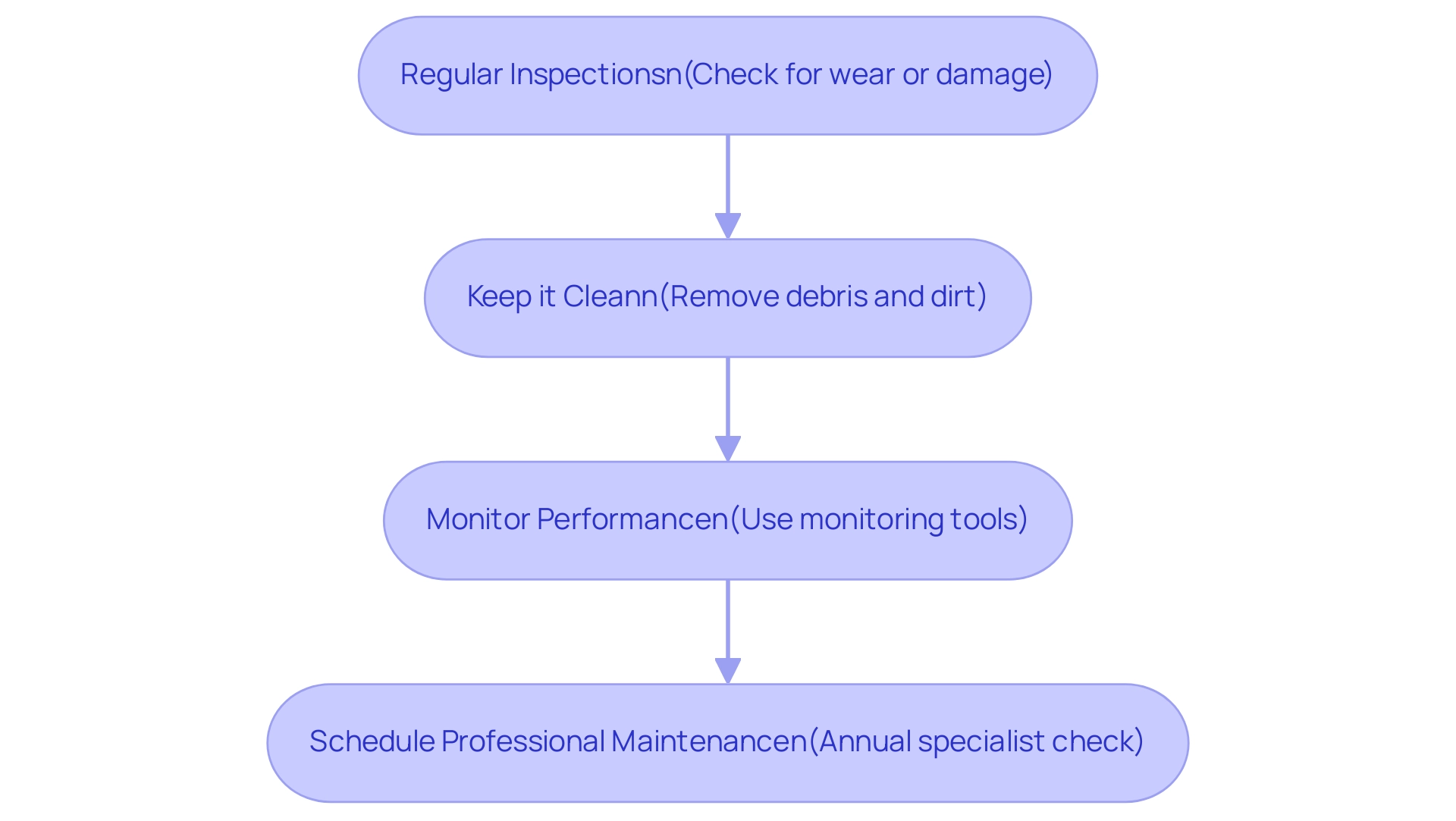Overview
The article provides a comprehensive step-by-step guide on how to successfully install an EV charging point, focusing on key considerations such as site selection, electrical infrastructure assessment, types of chargers, permits, costs, and maintenance. It emphasizes the importance of planning for accessibility, ensuring electrical capacity meets demand, and adhering to local regulations, thereby supporting homeowners in making informed decisions for a smooth installation process.
Introduction
As electric vehicles (EVs) continue to gain traction, the necessity for efficient and accessible charging solutions becomes paramount. Choosing the right location for an EV charging point is not merely a matter of convenience; it involves a careful assessment of various factors, including:
- Proximity to electrical supplies
- Local regulations
- Weather protection
By understanding the nuances of different charger types, evaluating electrical infrastructure, and navigating the complexities of permits, homeowners can ensure a seamless integration of EV charging into their daily lives. This article delves into essential considerations for selecting the optimal charging point location, the intricacies of electrical requirements, and the importance of ongoing maintenance, ultimately guiding readers toward making informed decisions in their transition to electric mobility.
Choosing the Optimal Location for Your EV Charging Point
- Assess Your Parking Situation: Begin by evaluating where your vehicle is predominantly parked. Choosing a site that guarantees easy access to the EV charging point installation is essential; it should not hinder traffic or pedestrian routes. As the demand for EVs grows, the importance of accessibility, especially through EV charging point installation, becomes increasingly significant in urban areas. It’s also important to consider that some power sources may be temporarily unavailable due to maintenance, which can affect overall accessibility.
- Proximity to Electrical Supply: Opt for a site that is close to your home’s electrical panel. This choice not only simplifies the installation process but also minimizes costs. Ideally, the power station should be located within 25 feet of the panel. This strategic placement is significant as it aligns with the Australian Government’s recent investment of AUD 39.3 million to support EV charging point installation along national highways, reflecting a commitment to enhancing accessibility for EV owners.
- Consider Weather Protection: Whenever possible, position your device in a sheltered area to shield it from harsh weather conditions. Choosing a location that provides shade during peak sun hours can prevent overheating and extend the lifespan of the power unit. This consideration is vital as smart chargers, which are increasingly connected to the internet, can optimize energy consumption, providing both convenience and efficiency for EV owners. Furthermore, advancements in Electric Road Systems (ERS) development illustrate the potential for vehicles to receive power while driving, indicating a future where energy accessibility will be even more integrated into daily travel.
- Check Local Regulations: It is essential to ensure that your selected placement location adheres to local zoning laws and any homeowners’ association guidelines. This step helps avoid potential legal challenges in the future. With recent changes in rules regarding EV power supply infrastructure, including those that may impact EV charging point installation, staying informed will guarantee your setup meets all necessary criteria. This proactive approach will pave the way for a seamless integration into your property and align with broader infrastructure advancements.
Additionally, maintaining clean solar panels is essential for maximizing energy efficiency and ensuring the longevity of your investment. The buildup of dust, dirt, and debris can lead to a loss of up to 25% of efficiency, which underscores the importance of regular cleaning. Powercore Electric offers professional solar panel cleaning services that can enhance energy production and support a sustainable lifestyle. Professional cleaning not only prevents potential damage but also extends the lifespan of solar systems by addressing issues before they escalate. Reach out to us today to discover more about our extensive services, including solar panels, battery backups, and EV power supply setups.
Understanding Electrical Infrastructure and Power Requirements
-
Evaluate Your Home’s Electrical Capacity: Begin by assessing your home’s electrical service capacity, typically noted in amps, such as 100A or 200A. As the demand for Electric vehicle (EV) refueling increases, particularly with forecasts of nearly 5,000 km of Electric Road systems in France by 2030, it’s essential to ensure your system can handle this additional load. A comprehensive assessment will assist in determining if your existing capacity accommodates the EV charging point installation, facilitating ease and cost reductions in your refueling routine. Remember, EV charging is easier than you think.
-
Consult with an Electrician from Powercore Electric Inc.: Engaging a licensed electrician is essential for a comprehensive assessment of your existing electrical setup. Powercore Electric Inc. provides a variety of services, including estimates, troubleshooting, safety inspections, circuit setups, and surge protection. Their expertise ensures that necessary upgrades, such as modifying your circuit or upgrading your panel, can be completed to guarantee safe and efficient EV charging point installation. As Greg Sowder, President of Qmerit Network, emphasizes,
Proper setup and upgrades are vital to accommodating the increasing demand for EV infrastructure.
Understand Power Requirements: Familiarize yourself with the power needs of different types of charging devices. Level 1 units typically require a standard 120V outlet and draw around 12 amps, while Level 2 units need a 240V outlet and can draw up to 80 amps, significantly influencing your home’s electrical load and installation requirements.
Plan for Future Needs: When assessing your electrical infrastructure, it’s prudent to contemplate potential future requirements, such as the possibility of adding more charging stations or upgrading to a higher-capacity unit. This foresight will ensure that your home remains adaptable to the evolving landscape of electric vehicle ownership through EV charging point installation. With initiatives like India’s FAME II program forecasting nearly 2 million public power stations by 2035, which necessitates installations every 25 km along major highways, homeowners should be ready for a rise in EV usage and the related infrastructure requirements. Furthermore, recent news emphasizes the Australian Government’s investment of AUD 39.3 million to construct EV stations along national highways, showcasing the increasing support for EV infrastructure globally. Furthermore, Germany’s adoption of a catenary system for Electric Road networks on its motorways establishes a benchmark for wider infrastructure initiatives in Europe, emphasizing the significance of planning for the future of EV power supply.
For more information or to schedule your consultation, contact Powercore Electric at ryan.serrano@powercoreinc.net or call (916) 699-8778.
Exploring Different Types of EV Chargers: Level 1 vs. Level 2
- Level 1 Devices: Utilizing a standard 120V outlet, Level 1 devices are the most basic type available, typically adding around 4-5 miles of range per hour. This makes them ideal for homeowners who plan to charge overnight and possess lower daily energy requirements. Given their simplicity, they can seamlessly integrate into most homes without requiring significant electrical upgrades.
- Level 2 Devices: Conversely, Level 2 units require a 240V outlet and provide a notably quicker power replenishment rate, contributing about 25 miles of range per hour. This rapid power replenishment capability makes them particularly suitable for daily drivers and individuals who require quicker turnaround times for their vehicles. Investing in a Level 2 device is a forward-thinking decision that aligns with the growing demand for EVs, especially as the market for electric vehicles continues to expand.
Consider Your Driving Habits: A critical factor in your power supply selection should be your daily mileage and charging frequency. For those who regularly drive long distances, the enhanced efficiency of a Level 2 device will likely prove more beneficial, offering the convenience of faster recharging during the day.
Setup Considerations: Regarding setup, Level 2 devices necessitate professional configuration due to their increased power requirements, ensuring safety and adherence to local electrical regulations. Conversely, Level 1 devices can usually be plugged directly into existing outlets, making them a more straightforward option for many homeowners.
As the demand for EV charging solutions increases, it is essential to consider the service options provided by Powercore Electric Inc. for EV charging point installation, which can assist in selecting and setting up the appropriate charging station for your needs. This context reinforces the importance of selecting the appropriate power supply type and highlights the services available to support your transition to electric vehicle ownership.
Navigating Permits and Regulations for EV Charger Installation
- Research Local Laws: Start your setup journey by consulting your local government or building department to identify specific regulations that govern EV charging point installation. Each state may have different laws that affect your options, so understanding these nuances is crucial.
- Obtain Necessary Permits: In many jurisdictions, acquiring permits for electrical work is mandatory. The process usually includes completing a permit application, submitting plans for setup, hiring a qualified electrician, scheduling inspections, and reaching out to the utility company if needed. Following these steps ensures that the EV charging point installation setup meets local building codes and safety standards, facilitating a smooth process.
- Consult with Your Installer: Engaging a qualified installer, such as Powercore Electric, is highly recommended. Our team specializes in EV charging point installation and is familiar with the permit application process, ensuring adherence to all necessary codes. According to industry experts, you won’t need a permit if you just want to charge an EV with a level 1 mobile connector or a level 2 plug-in charger, as long as you are using an existing outlet. This flexibility can simplify your initial power setup. Additionally, it is advised to discuss your energy plans with electric utilities to ensure your electrical capacity aligns with your needs and to understand available rates and incentives.
- Keep Records: It’s important to maintain a comprehensive file of all permits and inspections related to your EV charging point installation. This documentation is vital for compliance and may be required for future home sales or upgrades. Ensuring you have all paperwork in order will facilitate a smoother process down the line. Moreover, in 2021, ENERGY STAR established energy efficiency standards for DC fast devices up to 350 kW, which is a significant aspect for homeowners seeking to install high-efficiency power options. At Powercore Electric, we assist you through every phase of the process, from site assessment to testing and commissioning, ensuring a dependable and efficient EV charging point installation for your station.
Evaluating the Costs of EV Charger Installation and Potential Savings
-
The cost for EV charging point installation of a Level 2 charger typically ranges from $800 to $2,000. This variability relies on elements such as setup complexity, local labor rates, and the specific requirements of your property. For example, if your home requires extensive electrical work or upgrades, costs may rise significantly. Qualified electricians, such as those from Powercore Electric Inc., typically charge between $100 and $350 for standard setup procedures, making it essential to obtain multiple quotes to ensure competitive pricing.
Electrical Upgrades: When planning the installation, it’s crucial to account for possible electrical panel upgrades or the addition of new circuits. These enhancements, necessary for the EV charging point installation to accommodate the increased power demand from the EV charger, can add between $500 to $2,500 to your overall project cost. Powercore Electric’s expertise in substantial electrical renovations, including upgrading transformers and wiring, ensures the reliability and safety of your power infrastructure while significantly impacting total expenses. As highlighted in a recent case study involving a homeowner who upgraded their electrical system, these upgrades are essential for accommodating the power demands of EV charging point installation, which can ultimately affect your investment in the project.
Potential Savings: Numerous utility companies are enthusiastically encouraging the use of electric vehicles by providing incentives and rebates for EV equipment setups. For example, some areas offer cash rebates up to $500 for the EV charging point installation of a Level 2 charger, which can significantly lower your initial expenses. It’s advisable to research local utility offerings, as they can vary widely by region and may include cash rebates or tax credits that lower the overall investment. Furthermore, the installation of an EV charging point can enhance your property’s worth, making it more appealing to prospective buyers focused on sustainability.
Long-term Savings: Transitioning to an electric vehicle can lead to substantial long-term savings. Compared to gasoline, the cost of electricity for powering is generally lower, resulting in reduced fuel expenses. Furthermore, EV owners may be eligible for various tax credits and deductions, enhancing the financial attractiveness of making the switch. While residential setups are essential, it’s important to note that the EV charging point installation for commercial power sources entails significant investments, with Level 2 devices costing between $2,000 and $6,000 per port, and DC fast units ranging from $10,000 to $40,000. Powercore Electric is dedicated to offering extensive support for both residential and commercial fueling infrastructures. For more information on services, including solar panels and battery backups, contact Powercore Electric Inc. at ryan.serrano@powercoreinc.net or call (916) 699-8778.
Maintaining Your EV Charging Station for Optimal Performance
To ensure the longevity and efficiency of your EV power source, adherence to best maintenance practices is essential, especially for eco-conscious homeowners investing in sustainable energy solutions. Here are crucial steps to follow:
- Regular Inspections: Conduct periodic assessments of your charger, looking for visible signs of wear or damage. Pay particular attention to frayed cables and loose connections, as these issues can compromise safety and performance.
- Keep it Clean: A clean power station is vital for optimal functioning. Consistently eliminate debris and dirt that can disrupt the power process or create safety hazards.
- Monitor Performance: Utilize available monitoring tools or applications to observe your device’s performance metrics, including power-up durations and efficiency. Address any irregularities without delay to maintain optimal performance. Recent developments in EV charger performance monitoring have made this easier, providing real-time insights into your charger’s status.
- Schedule Professional Maintenance: It’s wise to have a specialist examine your power source at least once a year. Powercore Electric Inc. provides comprehensive service offerings, including inspections and maintenance for your EV power station, solar panels, battery backups, and EV charging point installation services. This proactive measure ensures that your system is running smoothly and can help identify potential issues before they escalate.
As EV adoption grows, the significance of EV charging point installation in sustaining your fueling infrastructure cannot be overstated. Omar Vargas, the leader of public policy at General Motors, highlights this necessity by stating, “We’re assisting that kind of planning, and we’re quite confident that in the next few years, we’re going to have a robust EV infrastructure in the United States.” This highlights the necessity for robust maintenance practices as the demand for charging stations grows, especially in areas currently experiencing disparities in access, as evidenced by the case study on the uneven distribution of public EV charging stations across the U.S.
Additionally, understanding that environmental factors, such as moisture and temperature extremes, can cause potential damage to your station reinforces the need for routine maintenance. Statistics show that battery replacements may cost as much as half the price of an EV’s initial cost, underlining the financial implications of neglecting maintenance. Furthermore, increased usage leads to more wear and tear on devices, making warranties an essential aspect of maintaining your investment.
By following these best practices, you can ensure your EV charger remains in top condition, providing a reliable resource for your electric vehicle, and maximizing the benefits of your solar energy solutions. Furthermore, exploring available government programs can enhance your investment in solar technology and battery backups, ensuring you make the most of your eco-friendly choices.
Conclusion
Selecting the optimal location for an EV charging point is crucial for ensuring convenience and efficiency in electric vehicle ownership. This article has highlighted several key considerations, including:
- The importance of assessing parking situations
- Proximity to electrical supplies
- Compliance with local regulations
Each of these factors plays a significant role in determining the best placement for a charging station, ultimately impacting accessibility and functionality.
Understanding the electrical infrastructure and power requirements is equally essential. Evaluating your home’s electrical capacity, consulting with professionals, and planning for future needs can prevent potential complications during installation. Moreover, differentiating between Level 1 and Level 2 chargers can help homeowners make informed decisions based on their driving habits and charging frequency.
Navigating the regulatory landscape and understanding installation costs further underscores the importance of thorough research and professional guidance. By securing the necessary permits and exploring available incentives, homeowners can not only ensure compliance but also reduce upfront costs and enhance the value of their properties.
Finally, maintaining an EV charging station is vital for optimal performance and longevity. Regular inspections, cleanliness, and professional maintenance can prevent costly repairs and enhance the efficiency of the charging unit. As electric vehicle adoption continues to rise, prioritizing these considerations will facilitate a smoother transition to electric mobility and contribute to a sustainable future.


